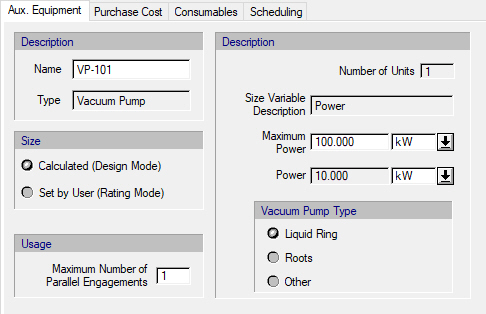

This tab is part of the Auxiliary Equipment Properties Dialog that is displayed for auxiliary equipment of the “Vacuum Pump” type. This dialog can be accessed by clicking on the View/Edit button ( ) from the Process Explorer Toolbar (Aux. Equipment tab) or on the Auxiliary Equipment Listing showing when selecting Tasks } Other Resources } Auxiliary Equipment... from the main menu of the application.
) from the Process Explorer Toolbar (Aux. Equipment tab) or on the Auxiliary Equipment Listing showing when selecting Tasks } Other Resources } Auxiliary Equipment... from the main menu of the application.
The following table shows the meaning of the variables appearing in this tab, as well as their default values and their generally acceptable range. Note that due to the manner by which the variables are used by the sizing and costing equations, the range of acceptable values may be further reduced.
|
Variable |
Default Value |
Range |
|
|
||
|
○ Name |
VP-101 |
Any Text |
|
● Type |
Vacuum Pump |
Any Text |
|
○ Maximum Number of Parallel Engagements |
1 |
Positive |
|
◙ Number of Units |
1 |
Positive |
|
● Size Variable Description |
Power |
Any Text |
|
◙ Maximum Power |
100.0 kW |
Positive |
|
◙ Power |
0.0 kW |
Positive |
Symbol Key: ○ User-specified value (always input); ● Calculated value (always output); ◙ Sometimes input, sometimes output
The following list describes the available specification choices in this tab; for more details on how these are implemented, see Vacuum Pumps.
In Calculate (Design Mode), the user specifies the Maximum Power and the program calculates the Number of Units and Power.
In User-Defined (Rating Mode), the user specifies the Number of Units and (rated) Power. The program simply displays a warning if the required power consumption per unit of the host operation exceeds the specified (rated) Power of the auxiliary equipment.
The selected vacuum pump type plays a role only if the power consumption option of the vacuum pump is set to “Calculated” through the Vacuum Pump Consumption dialog of the parent operation (which is displayed by clicking on the corresponding “Setup” button that exists in the “Oper. Cond’s” tab or in the “Vent/Emissions” tab of the parent operation). If the power consumption of the vacuum pump is set by the user, the vacuum pump type selection has no effect on the simulation results.
You may choose among three different vacuum pump type options:
● Liquid Ring
● Roots
● Other
If a liquid ring vacuum pump type is selected, and the power consumption of the vacuum pump is set to “Calculated” through the Vacuum Pump Consumption dialog of the parent operation, then the power consumption of the vacuum pump is calculated by assuming an isothermal compression model (the “Isothermal” compression model option is the only available option in the Vacuum Pump Consumption dialog). Then, the isothermal compression power can be calculated as follows:
Isothermal Compression Power = Suction Rate * Suction Pressure * ln(Exit Pressure/Suction Pressure).
On the other hand, if a roots vacuum pump is selected, and the power consumption option of the vacuum pump is set to “Calculated” through the Vacuum Pump Consumption dialog of the parent operation, then an isochoric compression model is assumed (the “Isochoric” compression model option is the only available option in the Vacuum Pump Consumption dialog) and the isochoric compression power is calculated as follows:
Isochoric Compression Power = Suction Rate * (Exit Pressure - Suction Pressure).
If the vacuum pump type option is set to “Other”, and the power consumption of the vacuum pump is set to “Calculated” through the Vacuum Pump Consumption dialog of the parent operation, then the user may choose either the isothermal compression model option or the isochoric compression model option through the Vacuum Pump Consumption dialog.
Through the same dialog, the user may also specify the compression efficiency of the selected (isothermal or isochoric) compression model option. By default, the compression efficiency is assumed equal to 30% for an isothermal compression model and 83% for an isochoric compression model. To calculate the actual vacuum pump power, the isothermal or isochoric compression power is multiplied by the specified compression efficiency.